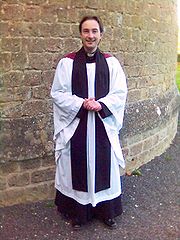
Tippet
Encyclopedia

Stole (shawl)
A stole is a lady's shawl, especially a formal shawl of expensive fabric used around the shoulders over a party dress or ballgown.A stole is typically narrower than a shawl, and of simpler construction than a cape; being a length of a quality material, wrapped and carried about the shoulders or arms...
or scarf
Scarf
A scarf is a piece of fabric worn around the neck, or near the head or around the waist for warmth, cleanliness, fashion or for religious reasons. They can come in a variety of different colours.-History:...
-like narrow piece of clothing, worn over the shoulders. They evolved in the fourteenth century from long sleeves and typically had one end hanging down to the knees. In later fashion, a tippet is often any scarf-like wrap, usually made of fur
Fur
Fur is a synonym for hair, used more in reference to non-human animals, usually mammals; particularly those with extensives body hair coverage. The term is sometimes used to refer to the body hair of an animal as a complete coat, also known as the "pelage". Fur is also used to refer to animal...
, such as the sixteenth century zibellino
Zibellino
A zibellino, flea-fur or fur tippet is a women's fashion accessory popular in the later 15th and 16th centuries. A zibellino, from the Italian word for "sable", is the pelt of a sable or marten worn draped at the neck or hanging at the waist, or carried in the hand. The plural is zibellini...
or the fur-lined capelets worn in the mid-18th century.
Ecclesiastical use

Anglicanism
Anglicanism is a tradition within Christianity comprising churches with historical connections to the Church of England or similar beliefs, worship and church structures. The word Anglican originates in ecclesia anglicana, a medieval Latin phrase dating to at least 1246 that means the English...
priests is called a tippet. The tippet is worn with choir dress
Choir dress
Choir dress is the vesture of the clerics, seminarians and religious of traditional churches worn for public prayer, either apart from the eucharist or by those attending the eucharist as the clergy part of the congregation rather than as the celebrants...
and hangs straight down at the front. Ordained
Ordination
In general religious use, ordination is the process by which individuals are consecrated, that is, set apart as clergy to perform various religious rites and ceremonies. The process and ceremonies of ordination itself varies by religion and denomination. One who is in preparation for, or who is...
clergy
Clergy
Clergy is the generic term used to describe the formal religious leadership within a given religion. A clergyman, churchman or cleric is a member of the clergy, especially one who is a priest, preacher, pastor, or other religious professional....
wear a black tippet, while licensed readers wear a blue one. In some countries it is normally simply referred to as a preaching scarf, black scarf, or blue scarf. The tippet is different from the stole, which although often worn like a scarf is a Eucharistic vestment
Vestment
Vestments are liturgical garments and articles associated primarily with the Christian religion, especially among Latin Rite and other Catholics, Eastern Orthodox, Anglicans, and Lutherans...
, usually made of richer material, and varying according to the liturgical colour of the day. Clergy who are entitled to wear medals, orders or awards may fix them to the upper left side of the tippet on suitable occasions (Remembrance Sunday
Remembrance Sunday
In the United Kingdom, 'Remembrance Sunday' is held on the second Sunday in November, which is the Sunday nearest to 11 November Armistice Day. It is the anniversary of the end of hostilities in the First World War at 11 a.m...
for example). Sometimes the right end of the tippet is embroidered with the coat of arms of the ecclesiastical institution of which the cleric is a member, but some deplore this usage. Tippets are often worn for the Daily Offices of Morning Prayer and Evensong
Evening Prayer (Anglican)
Evening Prayer is a liturgy in use in the Anglican Communion and celebrated in the late afternoon or evening...
. (Cf. Canon B8 of the Church of England, nb. the word "Scarf" is referring to the Tippet) However, Anglican Catholics
Anglo-Catholicism
The terms Anglo-Catholic and Anglo-Catholicism describe people, beliefs and practices within Anglicanism that affirm the Catholic, rather than Protestant, heritage and identity of the Anglican churches....
tend not to wear the tippet, preferring to wear the choir habit of Roman Catholic clergy instead.
The black preaching scarf (rarely blue, grey or green) is also worn by some Scottish Presbyterian
Church of Scotland
The Church of Scotland, known informally by its Scots language name, the Kirk, is a Presbyterian church, decisively shaped by the Scottish Reformation....
ministers and other non-conformist clergy.

